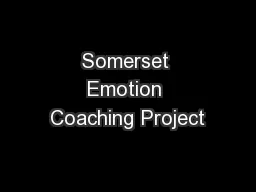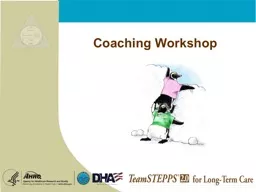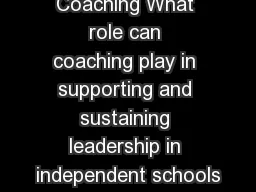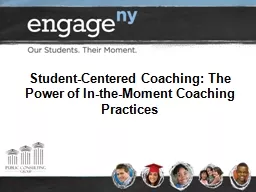PPT-Somerset Emotion Coaching Project
Author : karlyn-bohler | Published Date : 2018-02-03
Part 1 Why do we need it Part 2 What is it Part 3 How do we do it Emotion Coaching Feelings Matter Watch this clip Are you disrespecting me httpwwwyoutubecomwatchvzV1zK8zRCPoampfeaturechannel
Presentation Embed Code
Download Presentation
Download Presentation The PPT/PDF document "Somerset Emotion Coaching Project" is the property of its rightful owner. Permission is granted to download and print the materials on this website for personal, non-commercial use only, and to display it on your personal computer provided you do not modify the materials and that you retain all copyright notices contained in the materials. By downloading content from our website, you accept the terms of this agreement.
Somerset Emotion Coaching Project: Transcript
Part 1 Why do we need it Part 2 What is it Part 3 How do we do it Emotion Coaching Feelings Matter Watch this clip Are you disrespecting me httpwwwyoutubecomwatchvzV1zK8zRCPoampfeaturechannel. Theories of emotion. Our emotional state is closely related to our motivation. For each . behavior . that you perform there is an accompanying feeling about that action. Emotion influences motivation, and motivation influences emotion. . Workshop. Objectives. Define coaching and its outcomes. Describe the role of a TeamSTEPPS coach. List competencies of an effective coach. Describe how to implement coaching in TeamSTEPPS. TeamSTEPPS Phases . Leadership Coaching . Leadership Coaching as an Industry. Growth of industry and changing perception. . The perception of coaching has changed in the last 10 years. . Today,. “‘. h. aving a coach is almost a badge of honor. Student-Centered Coaching: The Power of In-the-Moment Coaching Practices “You don’t just walk into someone’s house and immediately begin moving around the furniture.” Carol Secondary Instructional Coach Top IAS Coaching in Delhi. Address, Contact Details, Fee Structure, Faculty, Infrastructure, Website and Location. Best UPSC Coaching in Delhi. Full information of the IAS Coaching in Nagpur. Top IAS Coaching in Nagpur. Details of IAS Coaching in Nagpur. Which is the Top UPSC Coaching in Nagpur for IAS exam preparation. Contact Details, address, fees, faculty, batch size & location of Best IAS Coaching in Nagpur. Rank wise Best UPSC Coaching in Nagpur. Details of Top IAS Coaching in Nagpur. Full information of the IAS Coaching in Kota. Top IAS Coaching in Kota. Details of IAS Coaching in Kota. Which is the Top UPSC Coaching in Kota for IAS exam preparation. Contact Details, address, fees, faculty, batch size & location of Best IAS Coaching in Kota. Rank wise Best UPSC Coaching in Kota. Details of Top IAS Coaching in Kota. Rank wise Best UPSC Coaching in Thane. Details of Top IAS Coaching in Thane. Full information of the IAS Coaching in Thane. Top IAS Coaching in Thane. Details of IAS Coaching in Thane. Which is the Top UPSC Coaching in Thane for IAS exam preparation. Contact Details, address, fees, faculty, batch size & location of Best IAS Coaching in Thane. Which is the Top UPSC Coaching in Ranchi for IAS exam preparation. Full information of the IAS Coaching in Ranchi. Rank wise list of UPSC Coaching in Ranchi. Details of Address, Batch size, Batch time, Location of the Top IAS Coaching in Ranchi. Best IAS Coaching in Ranchi. Details of IAS Coaching in Ranchi. Best UPSC Coaching in Thane. Details of IAS Coaching in Thane. Which is the Top UPSC Coaching in Thane for IAS exam preparation. Full information of the IAS Coaching in Thane. Rank wise list of UPSC Coaching in Thane. Details of Address, Batch size, Batch time, Location of the Top IAS Coaching in Thane. Best UPSC Coaching in Andheri. The Prayas India is today acknowledged as a multi-location, multi-program training specialist and offers a wide range of programs like Civil Services Coaching in Andheri. i.e. MPSC and UPSC, Banking, Railways, and other entrance examinations. One of the best IAS coaching in Ranchi, The Prayas India IAS Academy has assisted many students in achieving their IAS aspirations. If you share the dream of becoming an IAS officer, we will work with you to make that dream a reality. The best IAS classes in Ranchi undoubtedly help students, but their advice should be viewed as a tool rather than an aim in and of itself. There is no short path to being an IAS candidate. Once you\'ve made the decision to prepare, you must put in a lot of effort and provide enough time. You can\'t entirely rely on your classes. The Prayas India IAS | Best IAS Coaching in Dadar. 85/100 for IAS coaching Institute. One of Dadar\'s most well-known IAS coaching facilities is The Prayas India. For the success of its students, it offers extremely thorough and current study materials as well as a welcoming environment for students and knowledgeable faculty. Top UPSC Coaching in Ranchi. The Union Public Service Commission administers the Civil Services Examination across the country of India to select candidates for employment in the Indian Government\'s civil services, which include the Indian Administrative Service, Indian Foreign Service, and Indian Police Service. Read more about the top IAS coaching in Ranchi.
Download Document
Here is the link to download the presentation.
"Somerset Emotion Coaching Project"The content belongs to its owner. You may download and print it for personal use, without modification, and keep all copyright notices. By downloading, you agree to these terms.
Related Documents














